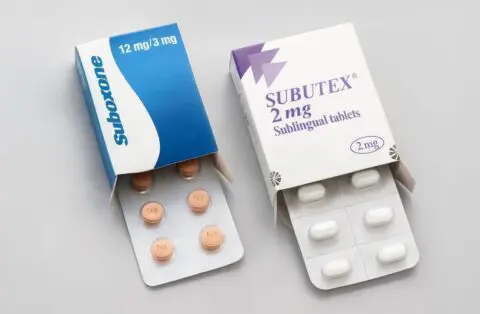What you’ll learn
We’ll explain the key differences between Subutex® and Suboxone®, two medications that play a key role in recovery from opioid use disorder (OUD). We’ll highlight the similarities, differences, how they work, and more.
Both Subutex® (buprenorphine) and Suboxone® (buprenorphine-naloxone) are prescription medications used to treat opioid use disorder (OUD). They’re designed to help ease withdrawal symptoms and reduce cravings for people seeking recovery.
Both of these medications contain the same active ingredient: buprenorphine. This ingredient helps stabilize the brain and body during withdrawal. Buprenorphine is a partial opioid agonist, which means it attaches to the brain’s opioid receptors but doesn’t fully activate them like heroin or fentanyl would. This helps reduce cravings and withdrawal symptoms without producing the same kind of high and with a much lower risk of misuse or overdose.
So, if both medications have buprenorphine, what’s the difference? The main distinction is that Suboxone contains another medication called naloxone, while Subutex does not. That one extra ingredient can make a big difference, especially when it comes to safety and how the medication is taken.
What is Suboxone?
Suboxone combines buprenorphine with naloxone, an opioid-blocking medication. The two work together to support recovery while reducing the risk of misuse.
The addition of naloxone in Suboxone adds an extra layer of safety, especially for those in early recovery. It helps reduce the risk of overdose and discourages misuse.
For people with opioid use disorder, this safeguard can make a big difference. Even when the intention is to stay on track, cravings and stress can trigger relapse. Having naloxone in your system can help protect you in those moments. The addition of naloxone in Suboxone’s composition isn’t a punishment. Think of it as a built-in “backup” to help you through the tougher moments in your recovery.
This built-in safeguard makes Suboxone a safer option for most people starting Medication-Assisted Treatment (MAT).
Why is there naloxone in Suboxone?
When naloxone is by itself, it is known as Narcan—the same medication that first responders such as paramedics and police officers give to people who have overdosed on opioids. Naloxone is an opioid antagonist (anti-opioid), which means it reverses the effect of opioids (and does so within minutes).
Naloxone is added to Suboxone to deter people from misusing it (injecting it or snorting it) in an attempt to get high.
If Suboxone is taken as directed (either sublingually under the tongue or pressed against the cheek), the naloxone it contains has no effect because it is not easily absorbed through the lining of the mouth or gut and, therefore, doesn’t enter the bloodstream. But if Suboxone is crushed and then injected, the naloxone enters the bloodstream and causes withdrawal symptoms rather than a high.
Because it’s a life-saving medication that can quickly reverse opioid overdoses, you can often get naloxone for free or as an over the counter (OTC) medication at a lower cost. This can be especially helpful for those whose insurance does not cover Narcan or those who do not have insurance. Many providers can also prescribe it, so you have access to it where it isn’t available over the counter. Additionally, many cities and communities throughout the country provide Narcan emergency kits for free.
What is Subutex?
Subutex is a medication used for the treatment of opioid use disorders. While it contains buprenorphine, it does not contain naloxone. Subutex works in a similar way to Suboxone, by easing withdrawal and reducing cravings.
So why would someone take Subutex instead?
In most cases, Subutex is prescribed in controlled environments, such as clinics or inpatient treatment centers. It’s generally not used as a long-term outpatient medication because, without naloxone, there’s a higher risk of misuse. However,
Subutex may be used in special situations, such as:
- If a patient has a known and documented allergy or adverse reaction to naloxone
- During pregnancy or breastfeeding, when providers want to reduce exposure to additional ingredients
When is Subutex prescribed for opioid addiction?
Because Subutex does not contain naloxone, there is a much larger chance of misuse compared to Suboxone. To help reduce that risk, Subutex is generally only given in clinics, hospitals, and withdrawal management facilities under the guidance of a licensed provider.
It is rarely prescribed for outpatient use, such as during maintenance therapy for OUD. At QuickMD, we always begin MAT treatment with a Suboxone prescription rather than Subutex.
We prescribe Suboxone because the naloxone it contains offers another guardrail to make your recovery as safe and supported as possible. We understand that recovery isn’t always a linear path. OUD is not a moral failing. It’s a treatable condition. When Suboxone is part of a MAT recovery program, if you relapse, the naloxone in your system can block and reverse its effects, preventing overdose.
The general exception to this is if a patient has a documented allergy or bad reaction to the naloxone in Suboxone.
What’s the difference between Suboxone and Subutex?
The difference between Suboxone and Subutex is that Suboxone contains naloxone, and Subutex does not. This additional ingredient helps protect against misuse, which is why Suboxone is usually medically preferred. You might hear Subutex called a “buprenorphine monoproduct” or “buprenorphine monotherapy” because it contains only one active ingredient.
A quick note on the brand name “Subutex”: The original makers of Subutex removed the brand-name version from the US market back in 2011. Today, it’s still available as a generic (buprenorphine without naloxone), but many people still refer to it as “Subutex” out of habit.
This chart provides a quick breakdown of the differences between Subutex and Suboxone:
| Subutex | Suboxone | |
| Active ingredients | Buprenorphine | Buprenorphine, naloxone |
| Available forms | Sublingual (under the tongue), buccal (in the cheek), injection, and patch | Dissolvable strips or film, sublingual tablets or pills |
| Brand status | Discontinued | Still available |
| Typical use | Buprenorphine dose of 4 to 24 mg | Buprenorphine dose of 2 to 24 mg |
| Misuse deterrent | None | Naloxone |
The biggest takeaway is that both Subutex and Suboxone work similarly in the body, but the addition of naloxone in Suboxone provides an extra safeguard.
Benefits of Subutex vs Suboxone
Both Subutex and Suboxone are effective tools in recovery from OUD. They help reduce cravings, ease withdrawal symptoms, and make it easier to focus on healing.
The main difference (and also the reason why most providers prescribe Suboxone) is the presence of naloxone. This added ingredient makes Suboxone a safer option for many people, especially in outpatient settings.
That said, some patients may benefit from Subutex instead. Your provider will work with you to find the option that fits your medical history, lifestyle, and recovery needs.
Which is better for treating OUD?
Both medications can be effective in treating opioid use disorder, but Suboxone is often a provider’s first choice because it includes naloxone. This added ingredient helps prevent misuse and offers another layer of protection if a relapse occurs.
While Subutex can work well too, it doesn’t offer the same safety net. That’s why it’s typically used in more limited situations or under close supervision. By contrast, Suboxone can empower people in recovery to remain as independent as possible, making taking their medication as prescribed a part of their everyday routine and a helpful tool in taking back control of their health.
No matter which medication is right for you, combining it with therapy or counseling can help you address the root causes of addiction and give you the strongest foundation for long-term recovery.
Can I switch from Suboxone to Subutex?
Prescriptions for the generic version of Subutex (buprenorphine without naloxone) are reserved only for patients who experience a negative reaction to naloxone, although this is rare. In those cases, switching medications might help ease discomfort.
If switching from Suboxone is medically appropriate, your provider will guide you through the process to make sure it’s done safely. While Suboxone and Subutex have a lot in common, even small differences in medication can affect how your body responds, so supervision and follow-up care are important.
How to take Subutex and Suboxone properly
Understanding how to take your medication properly can help you start feeling better in recovery. Let’s start with the basics:
- Subutex is a tablet that dissolves under the tongue (sublingually) and contains 8 mg of buprenorphine.
- Suboxone is available as a tablet or a film, both of which dissolve under the tongue. Tablets and films come in doses of 8 mg buprenorphine/2 mg naloxone or 2 mg buprenorphine/0.5 mg naloxone.
This is only an example of what a dosage can look like. Your schedule and dose can vary depending on your needs. Your provider is always there to help if you need a medication adjustment.
In order for your medications to work, the buprenorphine needs to enter your bloodstream. To do this, your medication strips have to come in contact with your mucosal membranes in your mouth. It’s important not to swallow your medication. This can make you feel queasy and sick, disrupting some of the opioid receptors in your gut.
Here are some simple steps to follow to take your medication safely:
- Wash your hands.
- Place the medication under your tongue.
- Wait for the medication to fully dissolve, typically 15 to 30 minutes.
- Rinse your mouth and spit.
Subutex and Suboxone in pregnancy
In the past, Subutex was often preferred during pregnancy due to concerns that naloxone might affect the baby. However, newer research suggests that both Suboxone and Subutex may be safe options while pregnant when prescribed and monitored appropriately.
At QuickMD, we typically prescribe Suboxone because it includes naloxone for added safety. That said, if you’re pregnant or breastfeeding, your provider will carefully evaluate your health history and discuss what’s best for you.
It’s worth noting that while brand-name Subutex is no longer sold in the U.S., the generic version (buprenorphine without naloxone) is still available when medically appropriate.
How to start MAT treatment with Suboxone
You can take Suboxone at home if it’s prescribed as part of a Medication-Assisted Treatment (MAT) plan. For many people, this makes starting recovery more manageable and less stressful.
If you’re living with opioid use disorder, we can help you start your recovery from the comfort of home. Our licensed providers can prescribe Suboxone (if medically appropriate) through secure video visits, making it easy to access care on your schedule.
Frequently asked questions about Suboxone vs Subutex
Why would you take Subutex instead of Suboxone?
Subutex may be prescribed instead of Suboxone if you’re unable to take naloxone. This is often the case for people who have had an adverse reaction to naloxone in the past, though extremely rare. Your provider will help determine what’s safest and most effective for your situation.
What happens if you switch from Subutex to Suboxone?
Switching from Subutex to Suboxone is usually a smooth process. Some people notice mild side effects, like nausea or sleep changes. However, these tend to go away quickly. Your provider can monitor your symptoms and make any adjustments needed to support your comfort during the transition.
Why don’t doctors prescribe Subutex?
Most doctors choose Suboxone over Subutex because it contains naloxone, which helps prevent misuse. If someone tries to inject or snort Suboxone, the naloxone kicks in to block the high and trigger withdrawal symptoms. This addition makes it a safer choice in many outpatient treatment settings.
Why was Subutex discontinued?
Subutex was discontinued in 2011. One reason was concern about its higher risk of misuse, since it didn’t contain naloxone. While the brand is no longer available, the generic version (buprenorphine without naloxone) is still prescribed in limited situations, typically under close medical supervision.




